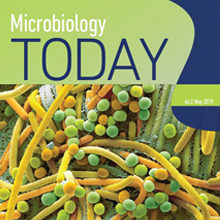Microbiology Today May issue: Metabolism, Health and Disease
07 May 2019

The May issue of Microbiology Today focuses on the varied interactions between humans and micro-organisms in terms of metabolism, health and disease. This issue’s feature articles focus on a range of microbes, including bacteria, viruses and fungi, looking at both the beneficial impact on human health and how they cause disease.
Kim R. Hardie starts off the issue with her article, examining the relationship between bacterial metabolism and virulence. Kim uses specific examples of a range of bacteria, to demonstrate the varied and complex ways in which metabolic products and processes can affect bacterial virulence.
The second feature article, written by Andrew Bell, Emmanuele Severi, Nathalie Juge and Gavin H. Thomas is about sialic acid, with a focus on its critical role in the human gut. They explain how it can provide bacteria with numerous advantages, such as an ‘invisibility cloak’ for immune evasion and acting as an energy source.
Sally Roberts and Joanna Parish discuss viruses in the next article, explaining how organotypic raft cultures can be used to study infection and pathogenesis. They start by introducing the stratified squamous epithelium, before describing the development of organotypic raft cultures and how they have been used to better understand viral infection and as a platform for the screening of antivirals.
Matthew D. Moore’s article looks at noroviruses and their interactions with bacteria. Matthew explains how some bacterial species have been shown to facilitate noroviral replication, while others appear to inhibit and inactivate the viruses. The article also covers the impact of the development of a ‘mini-gut’ on norovirus research and ends by looking at future questions to be answered.
The final feature article, written by Katharine Seton and Simon R. Carding, focuses on the diversity of the micro-organisms that colonise the human gastrointestinal (GI) tract. They start by describing how the human microbiota develops from birth and then explain how gut microbes are studied, what contributes to a healthy microbiota and associated health benefits. Finally, dysbiosis is discussed, including how it can contribute to disease and ways it can be treated.
The Comment article concludes this issue with a look at fungi and how they can impact human health. Courtney Kousser, Farhana Alam and Rebecca Hall explain how fungal interactions play important roles in health and disease, including in biofilm formation, antimicrobial resistance and immune ‘training’.
The issue also contains updates on our 75th anniversary projects, photos from this year’s Annual Conference and information about next year’s Annual Conference in Edinburgh, advice about open research and more.
View the latest issue online.


